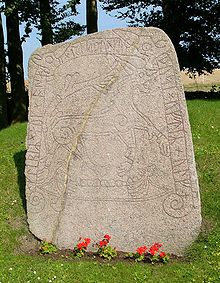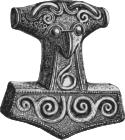- Naglfar
-
For the Swedish black metal band, see Naglfar (band).
In Norse mythology, Naglfar or Naglfari (Old Norse "nail ship") is a boat made entirely from the fingernails and toenails of the dead. During the events of Ragnarök, Naglfar is foretold to sail to Vígríðr, ferrying hordes that will there battle with the gods. Naglfar is attested in the Poetic Edda, compiled in the 13th century from earlier traditional sources, and the Prose Edda, written in the 13th century by Snorri Sturluson. The boat itself has been connected by scholars with a larger pattern of ritual hair and nail disposal among Indo-Europeans, stemming from Proto-Indo-European custom, and it may be depicted on the Tullstorp Runestone in Scania, Sweden.
Contents
Etymology
Some dispute has waged over the etymology of Naglfar. In the late 19th century, Adolf Noreen proposed that nagl- here does not have its usual meaning of "nail", but, instead, is a variant of Old Norse nár (meaning "corpse") and ultimately derives from Proto-Indo-European *nok-w-i. Noreen claimed that the notion of Naglfar as a "nail-ship" is due to a folk etymology; that elaboration on the folk etymology produced the concept of a "nail-ship".[1]
However, Sigmund Feist (1909) rejects the theory on etymological grounds, as does Albert Morley Sturtevant (1951) on the grounds of major difficulties, and their points have led Bruce Lincoln (1977) to comment that "there is no reason whatever to content that nagl- does not have its usual meaning of "nail" and that Naglfar is anything other than the nail-ship, just as Snorri describes it." In addition, Lincoln finds the ship to be a part of a larger pattern of religious disposal and sacrifice of hair and nails among the Indo-Europeans (see below).[1]
Attestations
Naglfar is attested in both the Poetic Edda and the Prose Edda. In the Poetic Edda, Naglfar is solely mentioned in two stanzas found in the poem Völuspá. In the poem, a deceased völva foretells that the ship will arrive with rising waters, carrying Hrym and Loki and with them a horde of others:
- Benjamin Thorpe translation:
- Hrym steers from the east, waters rise,
- the mundane snake is coiled in jötun-rage.
- The worm beats the water, and the eagle screams:
- the pale of beak tears carcasses; Naglfar is loosed.
- That ship fares from the east:
- come will Muspell's people o'er the sea, and Loki steers.
- The monster's kin goes all with the wolf;
- with them the brother of Byleist on their course.[2]
- Henry Adams Bellows translation:
- From the east comes Hrym with shield held high;
- In giant-wrath does the serpent writhe;
- O'er the waves he twists, and the tawny eagle
- Gnaws corpses screaming; Naglfar is loose.
- O'er the sea from the north there sails a ship
- With the people of Hel, at the helm stands Loki;
- After the wolf do wild men follow,
- And with them the brother of Byleist goes.[3]
In the Prose Edda, Naglfar is mentioned four times. The ship is first mentioned in chapter 43 of Gylfaginning, where the enthroned figure of High notes that while Skíðblaðnir is best the ship—constructed with the finest skill—"the biggest ship is Naglfari, it belongs to Muspell".[4]
 The Tullstorp Runestone in Scania, Sweden
The Tullstorp Runestone in Scania, Sweden
In chapter 51, High foretells the events of Ragnarök. Regarding Naglfar, High says that after the stars disappear from the sky, the landscape will shake so severely that mountains fall apart, trees uproot, and all binds will snap, causing the wolf Fenrir to break free. After, the Midgardr Serpent Jörmungandr will fly into a rage and swim to the shore, causing the ocean to swell unto land. Naglfar, too, will be break free from its moorings. High describes the composition of Naglfar as that of the untrimmed nails of the dead, and warns about burying the dead with untrimmed nails, stating that "the ship is made of dead people's nails, and it is worth taking care lest anyone die with untrimmed nails, since such a person contributes much material to the ship Naglfar which gods and men wish would take a long time to finish".[5] High adds that the ship will be captained by the jötunn Hrym, and that Naglfar will be carried along with the surging waters of the flood.[5] Further in chapter 51, High quotes the Völuspá stanzas above that references the ship.[6]
Naglfar receives a final mention in the Prose Edda in Skáldskaparmál, where it is included among a list of ships.[7]
Archaeological record
If the images on the Tullstorp Runestone are correctly identified as being from Ragnarök, then Naglfar is shown below the monstrous wolf Fenrir.[8] It has been pointed out that the ship image has beaks both fore and aft unlike any known Viking ship, and is likely to be a symbolic ship.[9]
Interpretations and theories
In his study of treatment of hair and nails among the Indo-Europeans, Bruce Lincoln compares Snorri's Prose Edda comments about nail disposal to an Avestan text, where Ahura Mazdā warns that daevas and xrafstras will spring from hair and nails that lay without correct burial, noting their conceptual similarities. Lincoln comments that "the specific image of Naglfar, the "Nail-ship," is undoubtedly specific to the Germanic world, although it does date to an ancient date within that area. But the basic idea on which it is based—that the improper disposal of hair and nails is an act which threatens the well-being of the cosmos-does ascend to the Indo-European period, as can be seen from comparisons [with Iranian myth]."[1]
See also
- Naglfari, depending on manuscript, a figure with a similar or identical name
Notes
References
- Bellows, Henry Adams (transl.) (2004 (1923)). The Poetic Edda. Dover (reprint of American-Scandinavian Foundation edition). ISBN 0-4086-43710-8. http://books.google.com/books?id=cJG6kfgZBf8C&printsec=frontcover&cad=0#v=onepage&q&f=false.
- Crumlin-Pedersen, Ole & Thye, Birgitte Munch (eds.) (1995). The Ship as Symbol in Prehistoric and Medieval Scandinavia: Papers from an International Research Seminar at the Danish National Museum, Copenhagen, 5th-7th May 1994. Nationalmuseet. ISBN 8789384016
- Faulkes, Anthony (Trans.) (1995). Edda. Everyman. ISBN 0-4608-7616-3
- Krappe, Alexander Haggerty (2003 (reprint of 1930 ed.)). Science of Folklore. Kessinger Publishing. ISBN 0766158136. http://books.google.com/books?id=yLxnfMHY2ywC&printsec=frontcover#v=onepage&q=&f=false.
- Lincoln, Bruce (1977). "Treatment of Hair and Fingernails among the Indo-Europeans" from History of Religions, Vol. 16, No. 4, The Mythic Imagination (May, 1977), pages 351—362. University of Chicago Press.
- Lindow, John (2001). Norse Mythology: A Guide to the Gods, Heroes, Rituals, and Beliefs. Oxford University Press. ISBN 0-19-515382-0. http://books.google.com/books?id=KlT7tv3eMSwC&printsec=frontcover#v=onepage&q=&f=false.
- Merrony, Mark (2004). The Vikings: Conquerors, Traders and Pirates. Periplus. ISBN 1902699548.
- McKinnell, John (2005). Meeting the Other in Norse Myth and Legend. D. S. Brewer. ISBN 1-84384-042-1. http://books.google.com/books?id=P2x2x3neFywC&printsec=frontcover&cad=0#v=onepage&q&f=false.
- Thorpe, Benjamin (Trans.) (1906). The Elder Eddas of Saemund Sigfusson, Younger Eddas of Snorre Sturleson. Norrœna Society. http://books.google.com/books?id=ptgRrQA4tjQC&printsec=frontcover&cad=0#v=onepage&q&f=false.
Norse paganism Deities,
heroes,
and figuresOthersAsk and Embla · Dís (Norns · Valkyries) · Dwarf · Einherjar · Elves (Light elves · Dark elves) · Fenrir · Hel · Jörmungandr · Jötunn · Sigurd · Völundr · Vættir
Locations Asgard · Bifröst · Fólkvangr · Ginnungagap · Hel · Jötunheimr · Midgard · Múspellsheimr · Niflheim · Valhalla · Vígríðr · Wells (Mímisbrunnr · Hvergelmir · Urðarbrunnr) · YggdrasilEvents Sources Society See also Categories:- Ships in Norse mythology
Wikimedia Foundation. 2010.
